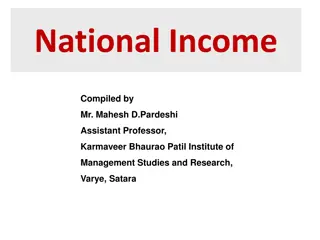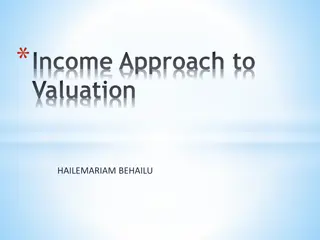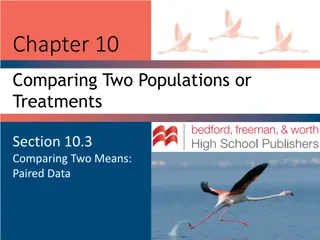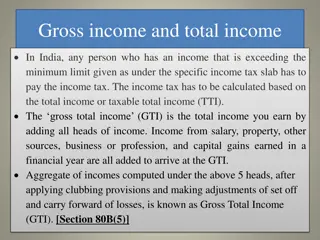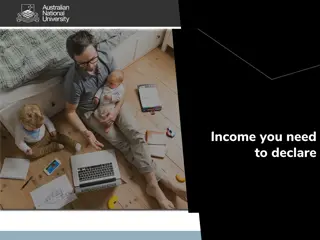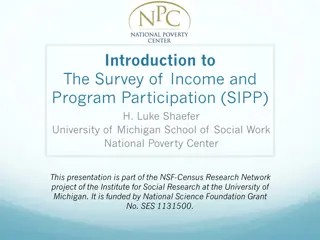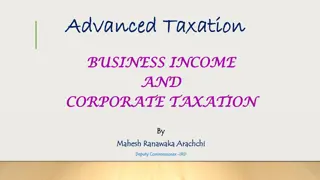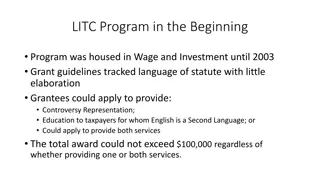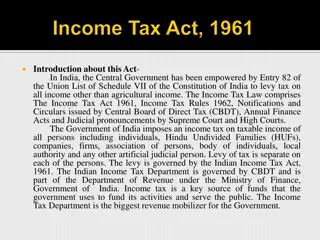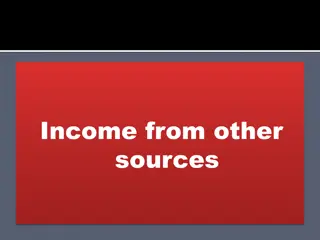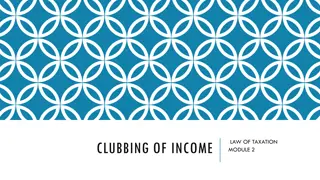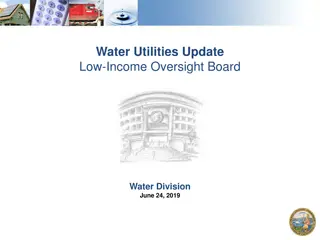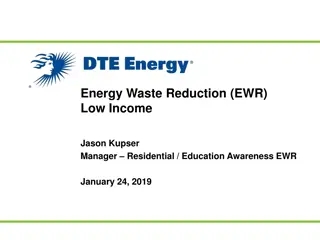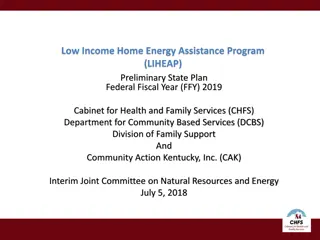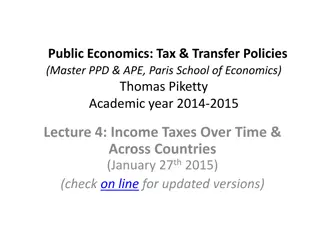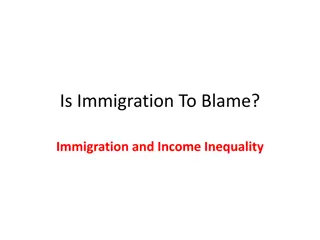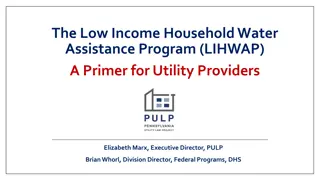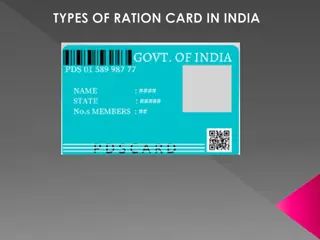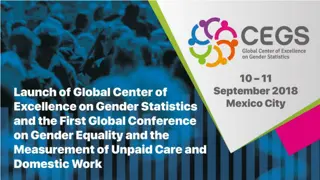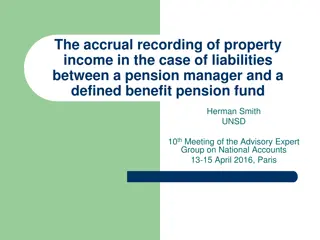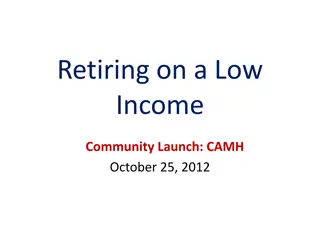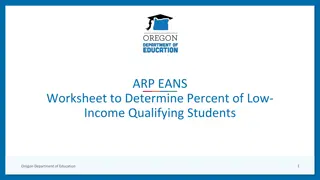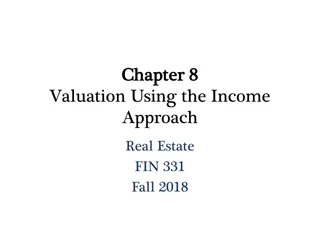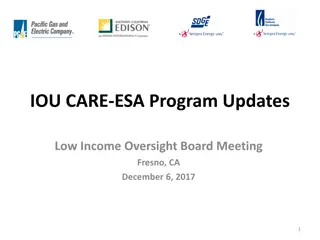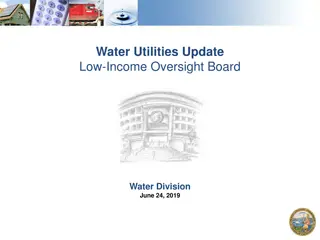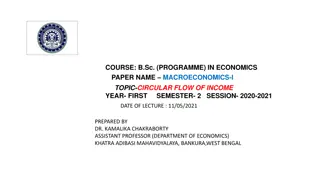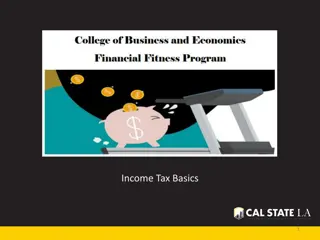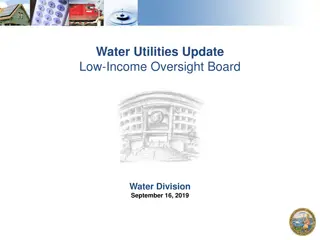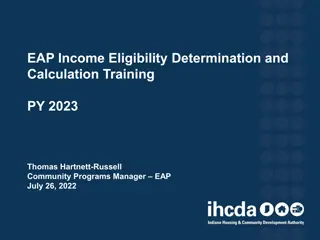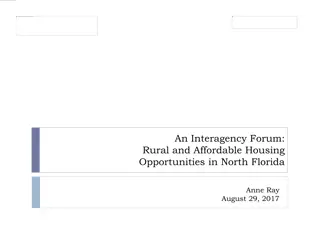Understanding Concepts of National Income in Economics
Explore the concepts of national income presented by Dr. Rashmi Pandey, covering key indicators such as Gross National Product (GNP), Gross Domestic Product (GDP), Net National Product (NNP), Net Domestic Product (NDP), Personal Income, Disposable Income, Per Capita Income, and Real Income. Gain ins
0 views • 22 slides
Understanding National Income and Its Importance in Economics
National income is a crucial measure of the value of goods and services produced in an economy. It provides insights into economic growth, living standards, income distribution, and more. Concepts such as GDP, GNP, Personal Income, and Per Capita Income help in understanding the economic health of a
5 views • 14 slides
Low Pay Household Estimates in Rural India
Analysis of data from the Periodic Labour Force Survey reveals estimates of households with monthly per capita earnings below a threshold in Rural India. The study, presented by Vasavi Bhatt, focuses on the characteristics of low earnings households and highlights the importance of decent work and i
1 views • 8 slides
Understanding the Income Approach to Property Valuation
The income approach to property valuation involves analyzing a property's capacity to generate future income as an indication of its present value. By considering income streams from rent and potential resale, commercial property owners can convert income forecasts into value estimates through proce
8 views • 49 slides
Chapter 10.Comparing Two Populations or Treatments
In a study of identical twins raised in high-income and low-income households, researchers compared IQ scores between the siblings. The analysis revealed that twins from high-income households had a higher mean IQ of 109.5 compared to 103.667 for those raised in low-income households. Although there
9 views • 52 slides
Understanding Income Tax in India: Gross vs Total Income
In India, income tax is calculated based on the total income or taxable total income. The gross total income includes earnings from all sources like salary, property, business, and capital gains. Various additions such as clubbing provisions, adjustments for losses, unexplained credits, investments,
0 views • 7 slides
Understanding Tax Obligations and Assessable Income in Australia
In Australia, residents are taxed on worldwide income while non-residents are taxed only on Australian-sourced income. The tax liability is calculated based on taxable income, tax offsets, other liabilities like Medicare levy, and PAYG credits. Assessable income includes employment income, super pen
0 views • 13 slides
Energy Assistance Workshop Series Statewide Assessment
The Energy Assistance Workshop Series conducted a statewide assessment to understand energy burden and discuss utility energy assistance programs. The goal was to evaluate the effectiveness of mechanisms for energy assistance to prioritize households with higher energy burdens. The workshops aimed t
0 views • 26 slides
Mississippi Home Corporation - National Housing Trust Fund Program Overview
Mississippi Home Corporation (MHC) administers the National Housing Trust Fund (HTF) Program in Mississippi to address housing needs for low-and-moderate-income residents. The program aims to enhance economic viability by providing safe, decent, and affordable housing options, helping families build
2 views • 95 slides
Introduction to the Survey of Income and Program Participation (SIPP)
The Survey of Income and Program Participation (SIPP) is a nationally representative, longitudinal survey providing data on income dynamics, government program participation, and social contexts of U.S. households. The SIPP aims to evaluate annual and sub-annual changes in income, program participat
0 views • 27 slides
Understanding Sri Lanka's Inland Revenue Act No. 24 of 2017
This content delves into the key aspects of the Inland Revenue Act No. 24 of 2017 in Sri Lanka, covering chargeability of income tax, imposition of income tax, definitions, sources of income, assessable income for residents and non-residents, income tax payable, and income tax base. It provides valu
0 views • 93 slides
Understanding Income from House Property in Taxation
House property income refers to rent received from properties owned by an individual, charged under income tax. It is based on the concept of annual value, representing the expected rental income or market value of the property. The annual value is taxable under the head "Income from House Property.
1 views • 12 slides
Evolution of Low Income Taxpayer Clinics (LITC) Program
The Low Income Taxpayer Clinics (LITC) Program has evolved over the years to ensure fairness and integrity in the tax system for low-income taxpayers and those who speak English as a second language. Initially housed in Wage and Investment, the program now reports to the National Taxpayer Advocate.
0 views • 10 slides
Overview of Income Tax Authorities in India
The Income Tax Act in India empowers the Central Government to levy taxes on all income except agricultural income. The Income Tax Department, governed by the Central Board of Direct Taxes, plays a crucial role in revenue mobilization. Understanding the functioning, powers, and limitations of tax au
0 views • 14 slides
Understanding Residuary Income and Taxable Sources
Residuary income, under section 56(1), includes all income not excluded from total income and subjected to income tax under "Income from other sources." Certain specific incomes listed in section 56(2) are taxable, such as dividends, winnings, employee contributions, interest on securities, and inco
0 views • 9 slides
Understanding Clubbing of Income in Taxation
Clubbing of income refers to including another person's income in the taxpayer's total income to prevent tax avoidance practices like transferring assets to family members. This concept is addressed in sections 60 to 64 of the Income Tax Act. Key terms include transferor, transferee, revocable trans
1 views • 16 slides
Water Utilities Update and Low-Income Oversight Board Summary Report
This report covers various topics such as low-income assistance, school lead testing, water rate design, school lead testing legislation, water production reports, and proposed funding for safe and affordable water. It also discusses acquisitions of smaller water systems and the benefits of consolid
0 views • 9 slides
Energy Waste Reduction (EWR) Low Income Program Overview
The Energy Waste Reduction (EWR) Low Income program by DTE Energy aims to reduce energy use for low-income households through various cost-effective measures. The program includes assistance for single-family homes and multifamily buildings, home energy consultations, and behavioral reports. Despite
1 views • 15 slides
Low-Income Home Energy Assistance Program (LIHEAP) Overview in Kentucky
The Low-Income Home Energy Assistance Program (LIHEAP) in Kentucky provides assistance to low-income households for their home energy needs. The program offers bill payment assistance, emergency aid, summer cooling support, and weatherization services. The Department for Community Based Services par
1 views • 23 slides
Millennial Avocado Shopper Trends: Growth Opportunities for Hass Avocados
This study focuses on identifying growth opportunities for Hass avocados by analyzing the purchase habits of Millennial avocado-purchasing households. Millennial households are found to be high-value segments in the avocado category, displaying behaviors that exceed those of Non-Millennial household
0 views • 15 slides
Evolution of Progressive Income Tax Systems
The concept of modern progressive income tax, developed in the early 20th century in countries like the UK, US, France, India, and Argentina, is based on the principle of a comprehensive tax base encompassing various income categories. The system involves effective vs. marginal tax rates, different
0 views • 19 slides
Exploring Immigration's Impact on Income Inequality
The presentation delves into the relationship between immigration and income inequality, analyzing data on income distributions among voters, non-voting citizens, and non-citizens in PA. It discusses the log-normal distribution as an approximation for income distribution and examines the ratio of me
0 views • 16 slides
Understanding Utility Affordability Challenges for Low-Income Households
Low-income households face significant challenges with utility affordability, especially during COVID-19. The lack of standardized affordability standards and the growing utility debts are exacerbating negative health outcomes and increasing the risk of eviction and homelessness for many families.
0 views • 37 slides
Types of Ration Cards in India and Their Benefits
In India, there are 5 types of ration cards - Priority Household (PHH), Antyodaya (AAY), APL (Above Poverty Line), BPL (Below Poverty Line), and AAY (Antyodaya). Each card serves a specific category of households, providing different amounts of food grain allocation per month. The PHH card is for el
0 views • 8 slides
Understanding Time Poverty and Income Poverty in Argentina
Measuring unpaid care and domestic work (UCDW) is crucial in assessing gender, time, and income poverty in Argentina. The Levy Institute Measure of Time and Income Poverty (LIMTIP) combines income and UCDW time requirements to determine poverty levels. Time deficits, when not compensated for, can le
0 views • 9 slides
California Affordable Connectivity Program (ACP) Initiative Overview
The California Affordable Connectivity Program (ACP) aims to bridge the digital divide by providing eligible households with high-speed Internet services. This initiative offers assistance to low-income individuals through various eligibility requirements and identity verification processes. With fo
0 views • 20 slides
Analysis of Irish Farmer Incomes Based on Income Tax Returns
This paper presents an analysis of Irish farmer incomes in 2010 using self-assessment income tax returns from the Revenue Commissioners. The study focused on various income sources such as trading income, rental income, employment income, social welfare transfers, and pension income. The dataset com
0 views • 12 slides
Accrual Recording of Property Income in Pension Management
The accrual recording of property income in the context of liabilities between a pension manager and a defined benefit pension fund involves accounting for differences in investment income and pension entitlements. This process aims to reflect the actual property income earned by the pension fund, c
0 views • 17 slides
Understanding Retirement Income for Low-Income Seniors in Ontario
Exploring the income system for retirees in Ontario, including Old Age Security, Canada Pension Plan, and private pensions. Addressing the concept of low income, eligibility for Guaranteed Income Supplement, and debunking common misconceptions with a top 10 list of bad retirement advice. Highlightin
0 views • 11 slides
Worksheet for Determining Percent of Low-Income Qualifying Students by Oregon Department of Education
Oregon Department of Education offers a worksheet to determine the percentage of low-income qualifying students at schools. Eligibility criteria include enrolling a significant portion of low-income students, with at least 23% of families having a household income not exceeding 185% of the 2020 Fede
0 views • 5 slides
Valuation Using the Income Approach in Real Estate
The income approach to appraisal in real estate involves converting future income into a present value through income capitalization. This method utilizes direct capitalization and discounted cash flow techniques to estimate property value based on net operating income. Estimating net operating inco
0 views • 17 slides
Understanding Taxation in Australia: Income Declaration and Assessment
Australian taxation laws require residents to declare worldwide income while non-residents are taxed on Australian-sourced income. The tax liability calculation involves taxable income, tax offsets, other liabilities such as Medicare levy, and PAYG credits. Assessable income includes various sources
0 views • 13 slides
Energy Efficiency Services Program Updates for Low-Income Households
The Energy Savings Assistance Program in California provides energy efficiency services to qualifying low-income households, such as weather stripping, insulation, and appliance upgrades to help manage energy bills. Updates include progress with federally-recognized tribes, ongoing outreach initiati
0 views • 12 slides
Water Utilities Update - Low-Income Oversight Board Summary
Water Utilities Update Low-Income Oversight Board on June 24, 2019 discussed topics such as low-income OIR workshop, school lead testing, conservation, proposed legislation, acquisitions, and human right to water. The workshop focused on water rate design for a basic amount of water at a low quantit
0 views • 9 slides
Understanding Set-off of Losses in Income Tax
Set-off of losses in income tax allows taxpayers to reduce their taxable income by offsetting losses from one source against income from another source. This process helps in minimizing tax liability and optimizing tax planning strategies. There are specific rules and exceptions regarding the set-of
0 views • 4 slides
Understanding Circular Flow of Income in Different Sector Economies
The circular flow of income concept explains the continuous flow of goods, income, and expenditure within an economy. It involves the distribution of income among production units and households through factors like land, labor, capital, and entrepreneurship. The flow of payments and receipts varies
0 views • 6 slides
Understanding Income Tax Basics
Income tax is a fundamental part of contributing to a civilized society, with various taxes like sales tax, gas tax, and alcohol tax playing a role. This guide explains how income tax works, including taxable income calculations and refund processes. It also covers what amounts are taxable, such as
0 views • 14 slides
Water Utilities Update on Low-Income Oversight Board - September 16, 2019
This update provides information on low-income programs related to water utilities, including total enrollments, discounts, lead testing in schools, and proposed statewide water low-income programs. It also discusses measures to increase the effectiveness of low-income programs through community-bas
0 views • 9 slides
Income Eligibility Determination Training for PY 2023
Explore the key changes and considerations in income eligibility determination for the upcoming program year 2023, including the use of State Median Income and Federal Poverty Guidelines. Learn about the refined definition of the income eligibility period and the importance of monitoring household i
2 views • 34 slides
Housing Trends in North Florida: Challenges and Opportunities
The data presented highlights the shift towards renting in North Florida, showcasing challenges faced by low-income households concerning affordability. The analysis delves into the impact of rising rents on various occupations and income levels, emphasizing the burden faced by renters, particularly
0 views • 20 slides

